A Beginner’s Guide To Long Tail Keywords

By Prebuilt Sites Team
November 29, 2021
EDITOR’S NOTE: When it comes to ranking for SEO, you’ve probably heard that long-tail keywords are easier to rank for and convert better. But is this true? It can be! We definitely recommend including long-tail keywords into your SEO strategy. But what even are long tail keywords? Long-tail keywords are search queries that get a small number of searches per month. They tend to be longer and more specific than their “head” counterparts and, therefore, often have a higher conversion rate. There are two types of long-tail keywords: topical and supporting. Topical long tail keywords represent a unique search query, while supporting long tail keywords are merely a less popular variation of a more popular search query. Both can be a part of an effective SEO strategy when used properly.
It depends. There are two different types of long-tail keywords, and some are no easier to rank for than their short-tail counterparts.
In this article, you’ll learn the differences between the two types of long-tail keywords and how to find them.
But first, let’s dive into the key things we’ll cover:
- What are long-tail keywords?
- Why are they called long-tail keywords?
- What makes long-tail keywords so great?
- How to find long-tail keywords?
- The two types of long-tail keywords
Long-tail keywords are search queries that get a small number of searches per month. They tend to be longer and more specific than their “head” counterparts and, therefore, often have a higher conversion rate.
For example, the keyword “meditation” is a “head” keyword because it gets 211k searches per month. The keyword “can meditation make you smarter” is a long-tail keyword because it only gets 50 searches per month.

Photo: Ahrefs
Long-tail keywords got their name from their position on the “search demand” curve. If we plot all search queries that people have performed in Google in the course of a month and order them by their search volumes, it’ll look somewhat like this:
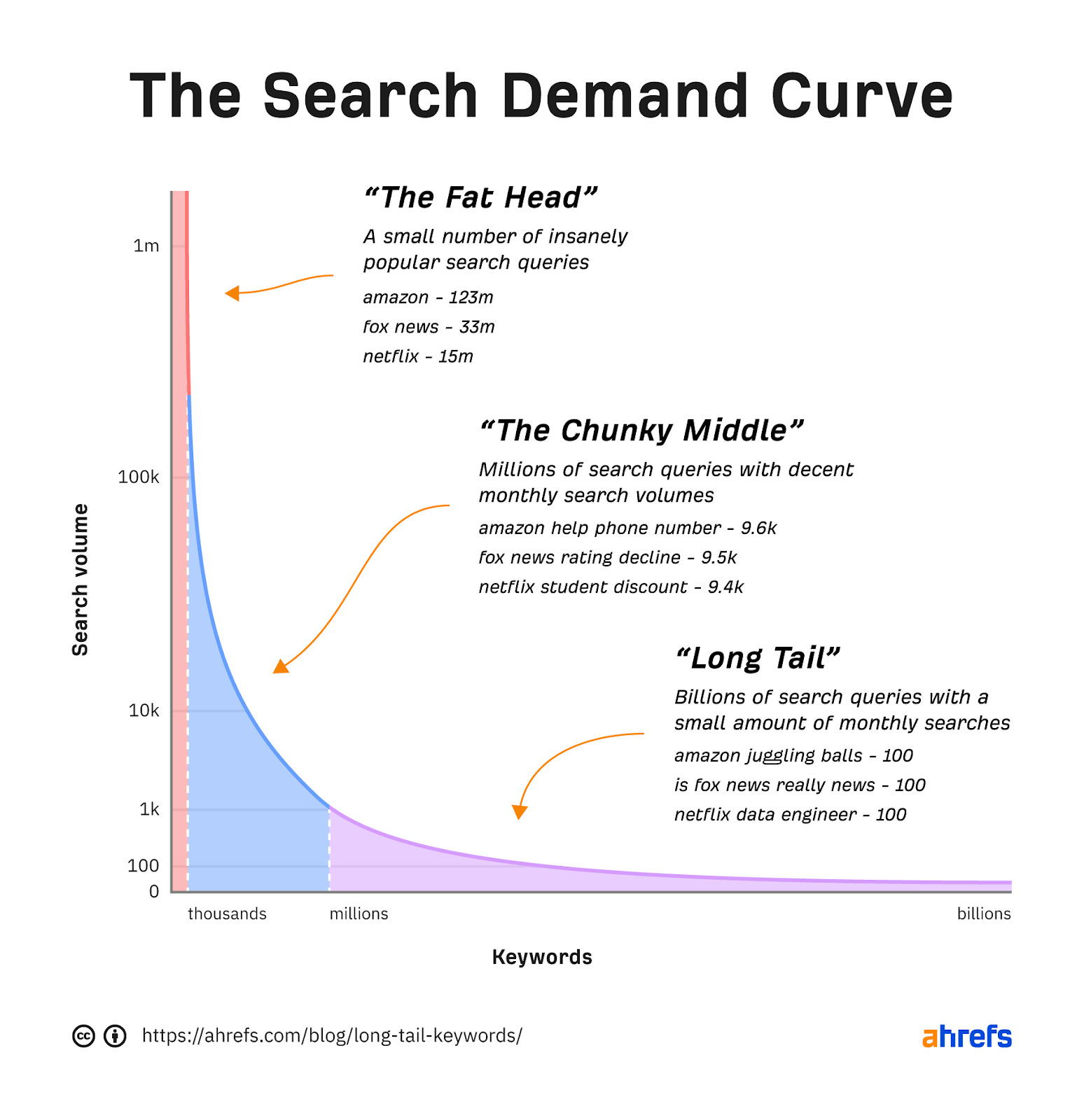
Photo: Ahrefs
At the “head” of the curve, we have a tiny number of keywords with super high search volumes, while the “tail” consists of billions of keywords with very low search volumes.
To be precise, in Ahrefs’ U.S. database (which is the biggest in the industry, by the way), there are just 31,000 keywords with search volumes of more than 100k searches per month; on the other hand, there are 3.8 billion keywords that have fewer than 10 searches per month.
Here’s how this looks like in a pie chart:

Photo: Ahrefs
As you can tell, keywords with fewer than 10 searches per month account for almost 95% of our U.S. keyword database. This should not really come as a surprise, given that ~15% of daily Google searches are new and have never been searched before.
95% of all search queries in the U.S. get fewer than 10 searches per month.
But to qualify as “long-tail,” a keyword doesn’t necessarily have to get fewer than 10 searches per month. And there’s no specific search volume threshold, which would define a keyword as “long-tail.” It mostly depends on the “head” keyword that you’re comparing it to.
What is a big mistake, though, is to define long-tail keywords by their length in words.
The thing is, there are many one-word keywords that get fewer than 100 monthly searches. There are also keywords five words long (or more) with hundreds of thousands of monthly searches.
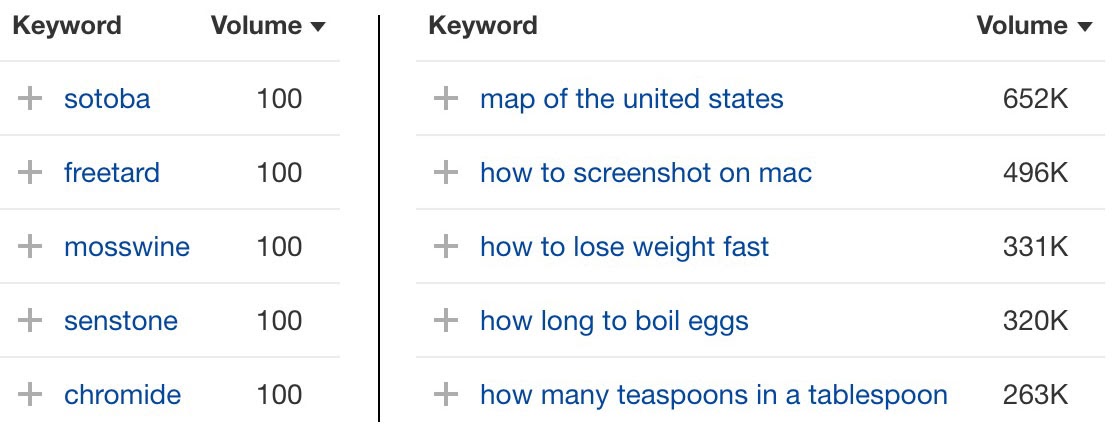
Photo: Ahrefs
So it is not the length of a keyword that makes it a long-tail. It’s the search volume of that keyword.
Here are three reasons why you should consider making long-tail keywords an integral part of your SEO strategy.
Reason 1. Long-tail keywords are (generally) a lot less competitive
Let’s say you’ve just launched a blog about cryptocurrencies. There are lots of popular keywords with high search volumes that could potentially drive LOADS of traffic to your blog:

Photo: Ahrefs
Those keywords are tempting to target. But let’s be real. What are the chances that your blog will rank for any of them anytime soon?
All of the above keywords have a high Keyword Difficulty (KD) score. This means it’ll be incredibly hard to get to the first page of Google for any of them. And if your website is brand new, that feat will be plain impossible.
Now let’s look at some of the less popular search queries for the topic of bitcoin:
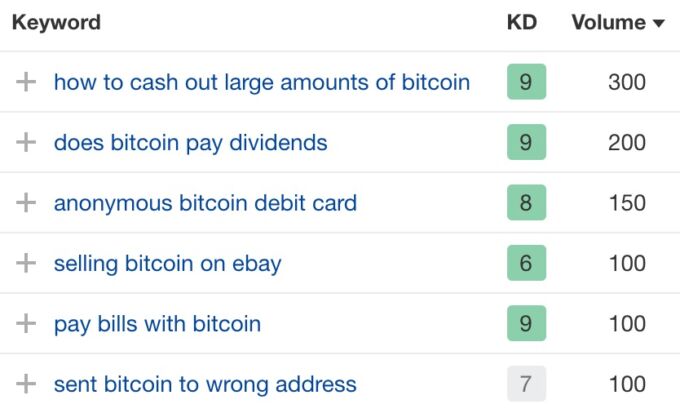
Photo: Ahrefs
As you can see, this time, their KD score is low. This means that even a new website has a chance to rank in the top 10 search results and get a few visitors from those keywords.
Reason 2. Long-tail keywords are (generally) easier to address
Let’s continue comparing the two sets of keywords above.
“How to buy bitcoin” seems like a rather straightforward question to answer. But if you look at the top-ranking page for that search query, it is actually 3,400 words long.
Conversely, the top-ranking page for “how to cash out large amounts of bitcoin” is just 1,000 words long.
The thing is, the more general the search query is, the more details you’ll have to include when addressing it. But if the search query is specific, you can often answer it rather briefly and still satisfy the searchers.
In other words, creating content for long-tail keywords generally requires less work.
Other than that, you can actually look for groups of similar long-tail search queries and address them with pages that only have a few differences.
For example, check out the following group of keywords:
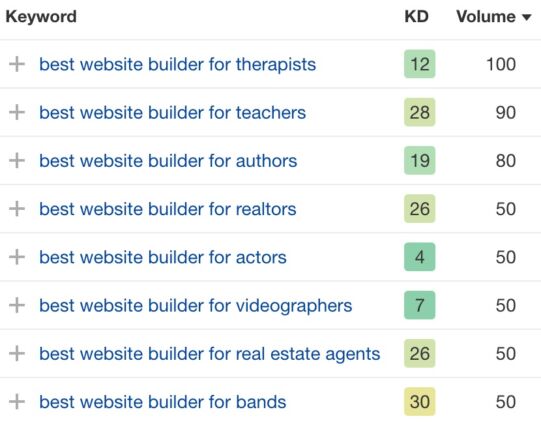
Photo: Ahrefs
The same website builder software would likely suit therapists just as well as it would suit teachers or actors. This means you can target all these different searches with pages that have 80% similar content, while the remaining 20% will be tailored to each user profile.
In other words, you can easily create a dozen pages in one day to address those similar long-tail searches.
Reason 3. There are LOTS of them
Yes, each individual long-tail keyword won’t open floodgates of traffic to your website. But as you address more and more of them, the search traffic will eventually compound to something pretty substantial.
And since there are lots of long-tail keywords in pretty much every industry, you’re unlikely to suffer from a shortage of them.
Back to my example of “best website builder for __” keywords. A search in Ahrefs’ Keywords Explorer returns over a thousand of them:

Photo: Ahrefs
There’s a number of methods you can use to find long-tail keywords. Some are more tedious than others, some are a tad “unconventional,” and some are just plain incorrect.
Let’s start with an incorrect one.
1. Use Google Autosuggest… NOT
Some SEO experts advise you to source long-tail keywords from Google Autosuggest by entering your target keyword followed by different letters of the alphabet.
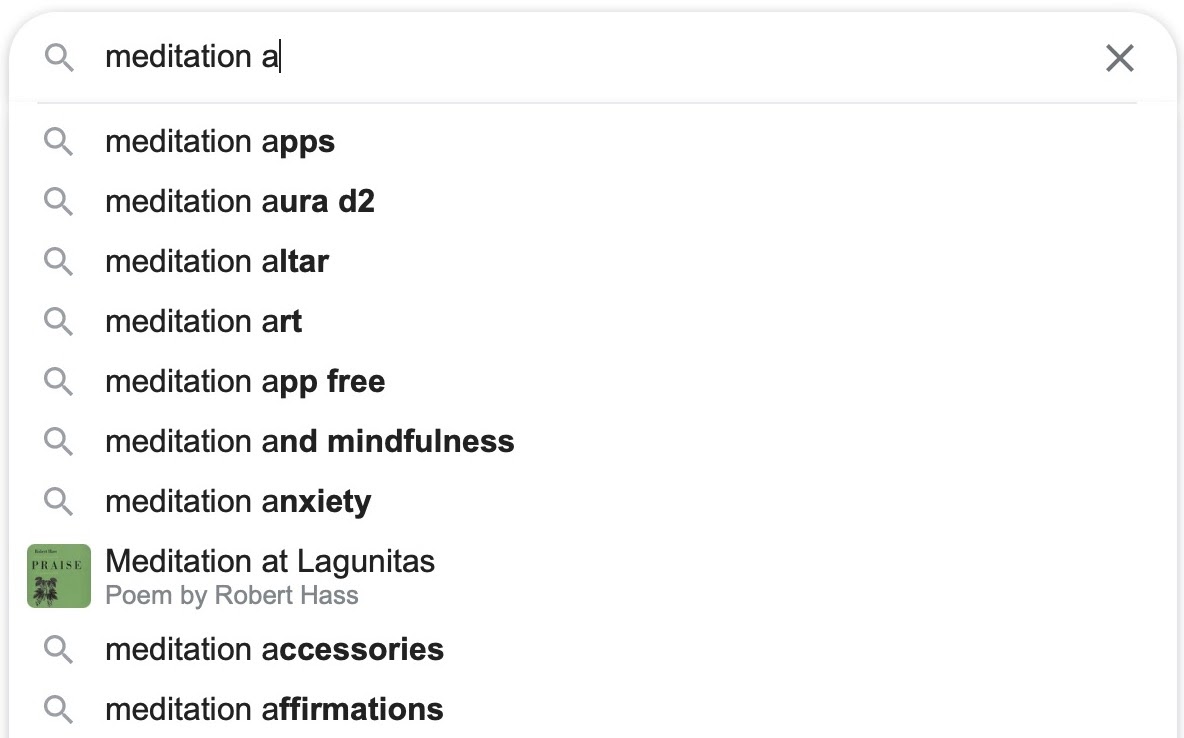
Photo: Ahrefs
Well, Google Autosuggest is a feature designed to give you quick access to popular search queries. So if we check the search volumes of keywords in the above screenshot, most of them will have a rather decent number of searches.

Photo: Ahrefs
In other words, Google Autosuggest is much more likely to offer you highly popular search queries rather than the coveted long-tails.
The same goes for online tools like Answer The Public or Soovle that scrape Autosuggest to generate their lists of keyword ideas. A large number of their keyword suggestions will turn out to be rather popular and competitive.
2. Use Ahrefs’ Keywords Explorer
Unlike the previous one, this method doesn’t require any tedious manual work. Just search for any word that defines your niche in Keywords Explorer and use the search volume filter to instantly see thousands of long-tail keywords.

Photo: Ahrefs
If your website is brand new and barely has any “authority,” then I recommend you to use the KD filter, which helps you find the least competitive keywords.
Also, make sure to try the “Questions” button. It often returns some cool long-tail search queries that are phrased as questions:
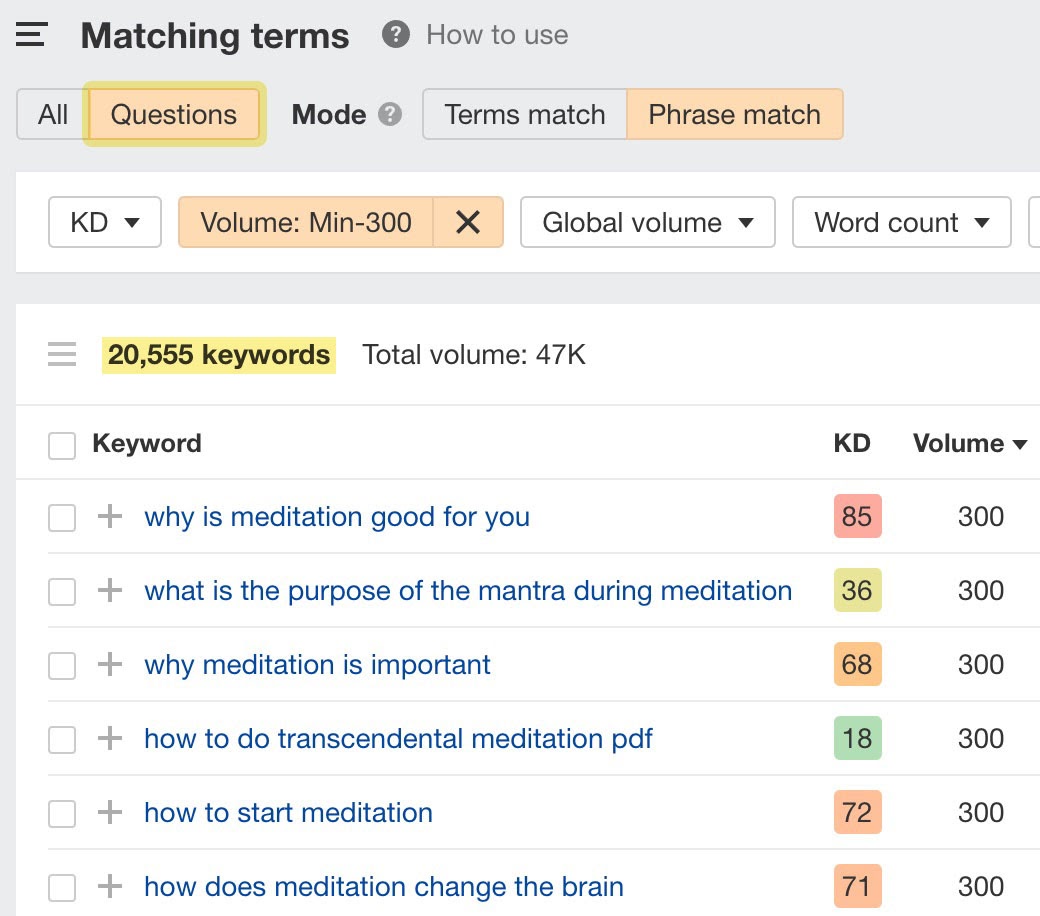
Photo: Ahrefs
3. See which keywords your competitors are ranking for
Another great source of long-tail keywords comes from your competitors. Ahrefs’ Site Explorer will help you see what long-tail keywords they are ranking for.
Just take a website belonging to your competitor, plug it into Site Explorer and go to the Organic keywords report to see which long-tail keywords are bringing traffic to their website:

Photo: Ahrefs
Repeat that with 5–10 of your competitors’ websites, and you’ll mine enough long-tail keyword ideas to keep you busy for months to come.
4. Browse Reddit, Quora, and niche forums
Whenever people visit Google and fail to find a good answer to their question, they ask it at places like Quora and Reddit.
For example, I was browsing the “marketing” topic on Quora and saw this post:
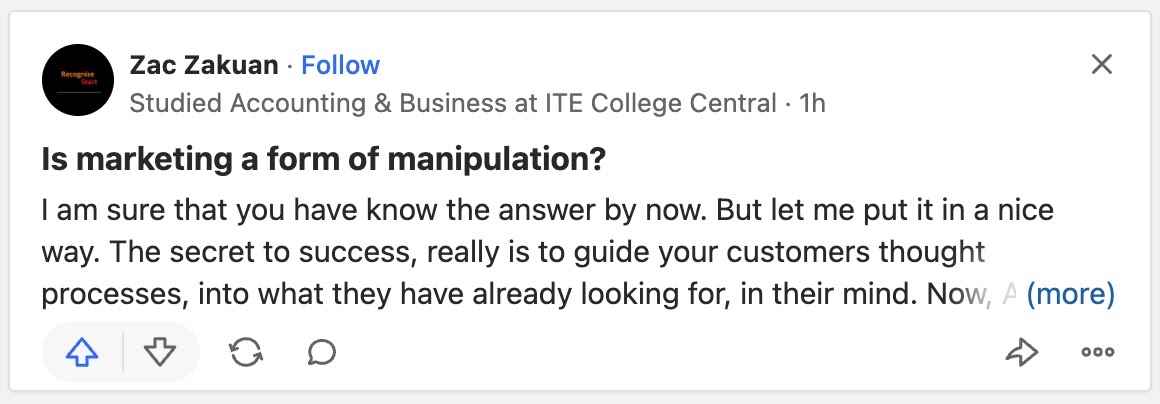
Photo: Ahrefs
A quick check in Keywords Explorer revealed that “marketing manipulation” is actually a long-tail keyword with a low KD score.
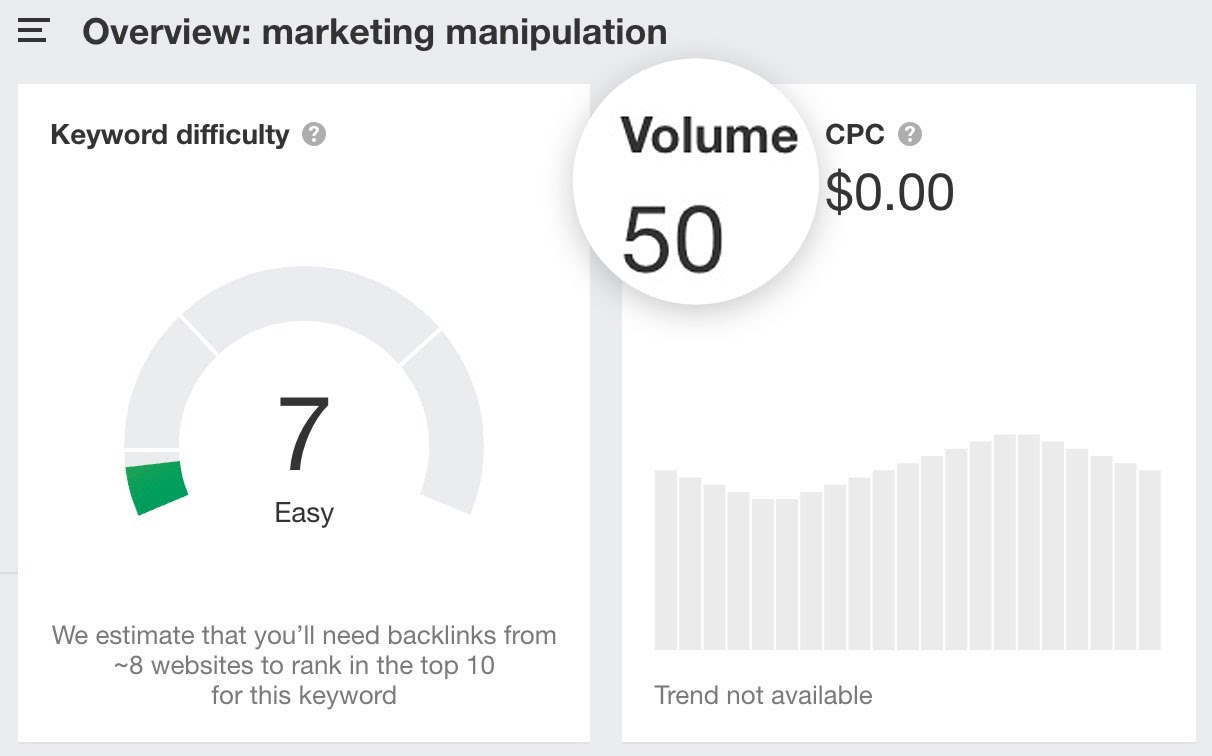
Photo: Ahrefs
The upside of this method is those forum threads may have some good discussions, which can be useful when creating a piece of content on that topic.
The downside is mining long-tail keywords from forums is a rather tedious process. And you’ll still have to use an SEO tool like Keywords Explorer to check for the search volumes and KD of your keyword ideas.
But the thing is, that same keyword can easily be discovered via Keywords Explorer in the first place:

Photo: Ahrefs
Not all long-tail keywords are the same. Some of them represent a unique search query, while others are merely a less popular variation of a more popular search query.
We call the former “topical long-tail keywords” and the latter “supporting long-tail keywords.”
Supporting long-tail keywords
Let me explain it with an example. “Best healthy treats for dogs” is definitely a long-tail keyword because it gets just 100 searches per month:

Photo: Ahrefs
But there are a few other search queries that mean the same thing while having a much bigger search volume:
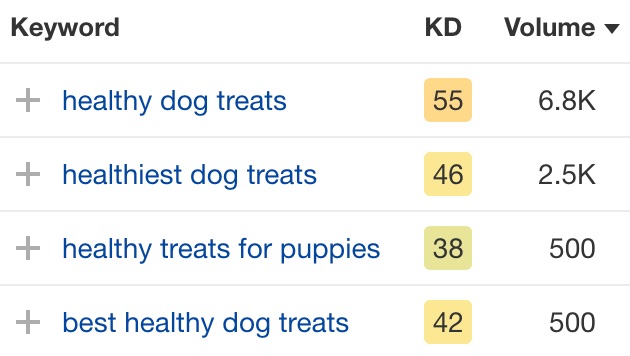
Photo: Ahrefs
If you search for each of them in Google, you’ll discover the same pages are ranking at the top for each of these keywords.
Google is smart enough to understand that different people phrase their searches differently while they look for the exact same thing. Therefore, it ranks the same set of pages for all these keyword variations.
This means if your page starts ranking for a popular search query like “healthy dog treats” (6.8k searches), it will automatically rank for all the query’s long-tail variations. So you don’t need to create individual pages for each long-tail variation. Rather, you should target them all with a single page.
But how do you know if a long-tail keyword you’re looking at is a part of a broader topic or not?
Well, here at Ahrefs, we have developed a unique feature just for that.
It’s called Parent Topic.
Whenever you enter a keyword into Keywords Explorer, we check the top-ranking page for that keyword and see if there’s a more popular search query this page is ranking for.
This is how it looks for “best healthy treats for dogs”:

Photo: Ahrefs
As you can see in the screenshot above, this long-tail keyword has a much more popular variation: “healthiest dog treats” (2.5k searches). And if you manage to rank for that search query, you’ll automatically rank for its supporting long-tail keyword too.
Topical long-tail keywords
Now let’s look at a different kind of long-tail keyword: “fly bites on dogs ears.”

Photo: Ahrefs
This time, the Parent Topic is the same as the original keyword. This means our keyword is actually the most popular way to search for this thing. And you can safely target this long-tail keyword with a dedicated page.
And once you manage to rank for this topical long-tail keyword, you’ll automatically rank for all the less popular “supporting” search query variations:
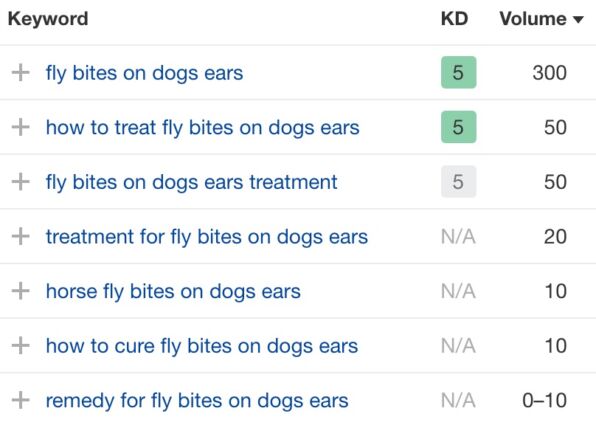
Photo: Ahrefs
But unfortunately, things aren’t always this straightforward.
Let’s examine one last search query: “natural sleep aid for dogs.”
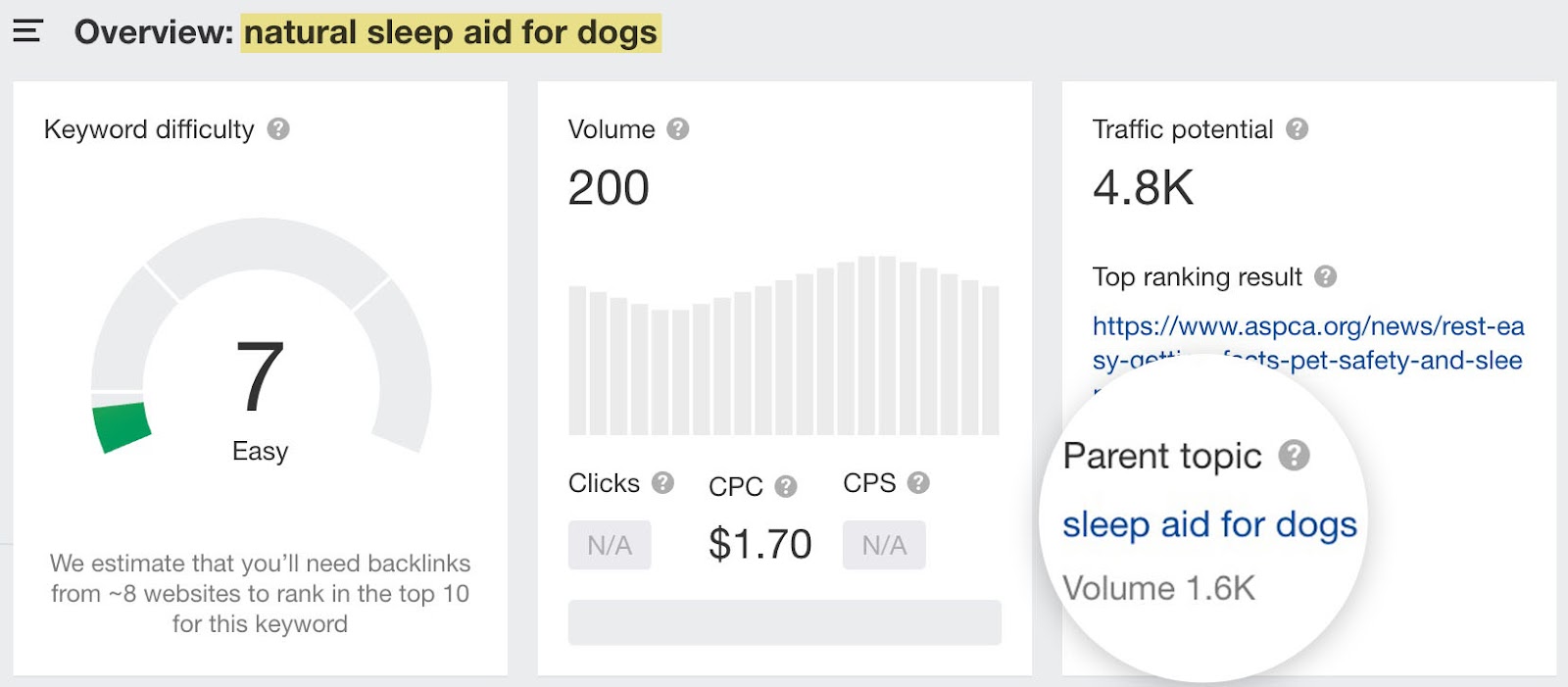
Photo: Ahrefs
The Parent Topic suggests this long-tail keyword is just a variation of the search query “sleep aid for dogs”(1.6k searches).
But I think the word “natural” in the original keyword actually makes it distinct from the suggested Parent Topic. People who search for it seem to be looking for a natural alternative to the usual pharmaceutical options.
And if we look at the top search results for that long-tail keyword, none of them seems to be talking about “natural sleep aid.” Rather, it talks about “sleep aids” in general:

Photo: Ahrefs
So I’d argue it does make sense to create a dedicated piece of content to target the keyword “natural sleep aid for dogs.” There’s a good chance it will actually rank #1 for that query—in the absence of any other articles that cover that specific topic.
In other words, you shouldn’t always blindly trust whatever the Parent Topic tells you. It’s just a computer algorithm and has its flaws and limitations. It is always a good idea to analyze the top-ranking pages for your keyword and figure out if your search query represents a distinct topic or a part of a broader topic.
Final thoughts
And that is all I have to say about long-tail keywords and what makes them so awesome.
Hopefully, this article will help you fine-tune your SEO strategy and accelerate the growth of search traffic to your website.
If you have any further questions, feel free to ping me on Twitter.
Originally posted on Ahrefs.

